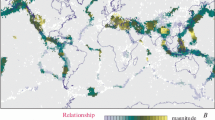Summary
The scale independent inclusion theory of rock failure developed in Part I is applied to the problem of crustal earthquakes and, in particular, to the problem of premonitory phenomena reported to precede such earthquakes. Several well-known premonitory effects such as anomalous variation in the ratio of longitudinal (V p ) and shear (V s ) seismic velocities,V p /V s , tilt, regional and local crustal movements and stress axis rotation, to mention a few, are shown to be a natural consequence of the physical processes leading to failure in dry rock. The effects of fluids on failure in the focal region of a potential earthquake are considered in terms of the scale independent inclusion theory.
Similar content being viewed by others
References
Aggarwal, Y. P., Sykes, Lynn R., Armbruster, J., andSbar, M. L. (1973),Premonitory changes in seismic velocities and prediction of earthquakes, Nature241.
Blake, W., Rock Burst Research at the Galena Mine, Wallace, Idaho, USA, BuMines Tech. Progress Report, TPR 39, 1971.
Booker, J. R. (1974),Time dependent strain following faulting of a porous medium, Geophys. Res.79, (14), 2037–2044.
Brady, B. T. (1973),A mechanical equation of state for brittle rock, Part II, Int. J. Rock Mech. Min. Sci.10, 291–309.
Brady, B. T. (1974),Seismic precursors prior to rock failures in underground mines, Nature252, 549–552.
Brady, B. T. (1974)Theory of earthquakes — Part I — A scale independent theory of rock failure, Pure appl. Geophys.112, 701–725.
Byerlee, J. D., The Fractional Characteristics of Westerly Granite, Ph.D Thesis, Mass. Institute of Technology, 1966.
Chermyavsky, A. Atmospheric-Electric and Electrotelluric Phenomena in Earthquakes, Cots Nauka I Telonika, Tashkent, 1963.
Healy, J. H., Lee, W. H. K., Pakiser, L. C., Rayleigh, C. B., andWood, M. D. (1972),Prospects for earthquake prediction and control, Tectonophysics 319–332.
Hosoyama, K. (1952),Characteristic tilt of the ground that preceded the occurrence of the strong earthquake of March 7, 1952, J. Phys. Earth1, 75–81.
Iida, K., andKumazawa, M. (1961),Measurements of elastic wave velocities in volcanic rocks at high temperatures by means of ultrason c impulse transmission, J. Earth Sci.9.
Kato, Y., andUtashiro, S. (1949),On the changes of terrestrial magnetic field accompanying the great Nankaido earthquake of 1946, Sci. Rep. Tôhoku Univ., Serces 5, Geophysics1.
Latynina, L. A., andKarmaleyeva, R. M. (1970),On certain anomalies in the variations of crustal strains before strong earthquakes, Tectonophysics9, 239–247.
Moore, G. W. (1964),Magnetic disturbances preceding the 1964 Alaska earthquake, Nature203.
Nersesov, I. L., andSimbireva, I. G.,Regularities in the Distribution of Stresses in the Foci of Weak Earthquakes in the Garm Area and Their Relationship to Seismicity, Third All-Union Symposium of the Seismic Regime, June 3–7, 1968, Part I, pp. 147–181.
Parkhomenko, E. I., andBandarenko, A. T. (1963),Investigation of the electric resistivity of rocks at pressures up to 40,000 kg/m 2 and temperatures up to 400° C, Izv. Akad, Nauk SSSR, Geofiz. Ser.12, 1106–1111.
Rikitake, T. (1972),Earthquake prediction studies in Japan, Geophys. Surv.1, 4–26.
Sadovsky, M. A., Nersesov, I. L., Nigmatullaev, S. K., Latynina, L. A., Lukk, A. A., Semenov, A. N., Simbireva, I. G., andUlomov, R. I. (1972),The processes preceding strong earthquakes in some regions of Middle Asia, Tectonophysics14, 296–307.
Sassa, K., andNichimura, E. (1956),On phenomena forerunning earthquakes, Bull. Disast. Prev. Res. Inst., Kyoto Univ.13, (1), 1–8.
Scholz, C. H., Sykes, L. R., andAggarwal, Y. P. (1973),The physical basis for earthquake prediction, Science181 (4102), 803–810.
Semenov, A. M. (1969),Variations in the travel time of transverse and Longitudinal waves before violent earthquakes, Isv. Earth Physics4, 245–248.
Sobolev, G. A., andMorozov, V. N. Local disturbances of the electrical field on Kamachtka and their relation to earthquakes, inPhysical Bases of Seeking Methods of Predicting Earthquakes, M. Sadovskii, Ed. 1970.
Stacey, F. D.,Physics of the Earth (John Wiley and Sons, Inc., New York 1969), 324 pp.
Whitcomb, J., Garmany, J., andAnderson, D. (1973),Earthquake prediction: Variation of seismic velocities before the San Fernando earthquake, Science180, 632–635.
Wood, M. D., andAllen, R. V. (1971),Anomalous Microtilt preceding a local earthquake, Bull. Seism. Soc. Am.61, 1801–1811.
Wyss, Max (1973),Towards a physical understanding of the earthquake frequency distribution, J. Geophys. Res.31, 341–359.
Wyss, M., andHolcomb, D. J. (1973),Earthquake prediction based on station residuals, Nature245.
Author information
Authors and Affiliations
Rights and permissions
About this article
Cite this article
Brady, B.T. Theory of earthquakes. PAGEOPH 113, 149–168 (1975). https://doi.org/10.1007/BF01592907
Received:
Issue Date:
DOI: https://doi.org/10.1007/BF01592907




